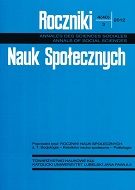Kwoty na listach wyborczych w 2011 roku. Przedwyborcza debata zwolenników i przeciwników parytetów
Quotas on the Electoral Lists in 2011. The Pre-Election Debate between the Advocates and Opponents of the Political Representation Parity
Author(s): Agnieszka Łukasik-TureckaSubject(s): Social Sciences
Published by: Towarzystwo Naukowe KUL & Katolicki Uniwersytet Lubelski Jana Pawła II
Keywords: parity; electoral lists; quotas; parliamentary elections of 2011
Summary/Abstract: Held in June 2009, the Women’s Congress gave rise to a civic project of an act that would guarantee the candidates in the parliamentary elections an equal share in the political representation on the electoral lists. This project evoked a medial debate on the issue of parity in political representation. The debate lasted for a year and a half, granting both sides enough time to presents their lines of argumentation. The supporters of the idea of parity focused on the notion of social justice, social benefits from the use the resource of women’s aptitudes and competences, and on covering by political action of those areas of social life that had already been ignored by men. The opponents, on the other hand, pointed out that the idea of parity meant another top-down, despotic intervention in the statistic figures relating to the Polish society. This social action was also claimed to cause the danger of a never-ending spiral of conflicted claims and demands of newer and newer social groups. First and foremost, the idea of parity was said to ridicule the womenpoliticians, since it produced an image of a woman who is not capable of reaching political success without support. The medial debate moved from the press to the Polish parliament. The debate ended in a rise in the parity quota for the Polish parliamentary system to 35 per cent. When signed by the President of Poland, the new law became effective for the elections for the Polish and the European Parliaments, commune and district councils as well as provincial diets. The guaranteed 35 per cent did not bring about any significant increase in the presence of women in the Polish parliament. The percentage of their political representation in the parliament rose from 20 to 23 per cent.
Journal: Roczniki Nauk Społecznych
- Issue Year: 40/2012
- Issue No: 3
- Page Range: 127-138
- Page Count: 12
- Language: Polish

